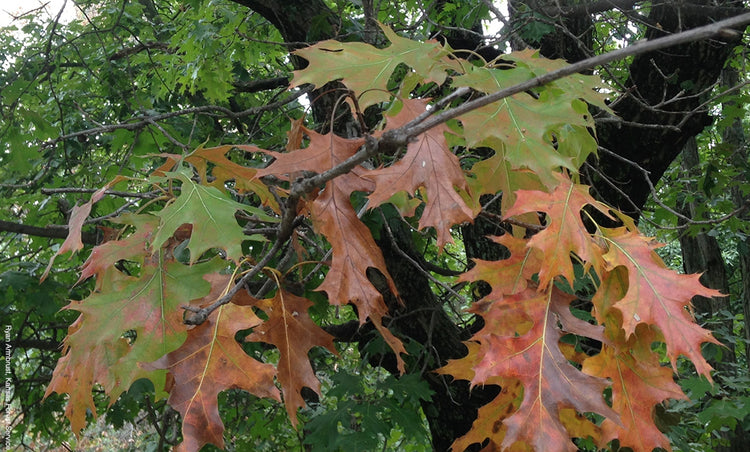
Source: Canadian Food Inspection Agency
Symptoms that can help you identify trees affected by oak wilt include: brown leaves, early leaf fall, vertical cracks in the tree trunk (caused from the pressure exerted by the growing fungus) and white, grey, or black fungus growing just under the tree bark. Additionally, as described by the Invasive Species Centre, the leaves of infected trees start browning around the edges of the leaf and work their way inward. Trees also typically brown from the top down.

Oak leaves browning from the outside edge inward. Source: Invasive Species Centre
It’s important to keep in mind that there are many other possible reasons for crown dieback and browning foliage such as insects and other fungal diseases. Scorch and anthracnose are probably the most likely to be confused with oak wilt. The signs and symptoms in and under the bark are probably more reliable indicators when examining trees on the landscape.
The importance of oak trees in our ecosystems
Oak trees are no ordinary trees. They're one of the most important keystone species in our ecoregion, supporting more species of Lepidoptera (caterpillars, moths, and butterflies) than any other genera, according to the National Wildlife Federation. And by supporting all of these insects, the mighty oak thereby supports the biodiversity of the entire food web.
While the threat of oak wilt is a serious one, there are still many things we can do to protect our native biodiversity. The most important thing is to minimise the spread. Oak wilt has been present in North America for many decades, and its spread can be managed effectively if the appropriate precautions are taken.
How does oak wilt spread?

Photo of a sap beetle (nitidulid) Source: Good Fruit Grower
"Oak Wilt most frequently spreads from tree-to-tree by root-to-root contact... Oaks like to be 'hooked-up' with each other and swap spit. Kidding aside, once the pathogen has entered one tree, it has the potential to move from tree-to-tree quite readily and efficiently." Steve Houser, Consulting Arborist
Oak wilt can spread two ways. The first is through underground root grafts between oak trees. This means that oak trees planted near each other can all die around the same time (a big concern for our little forests). The second method, though infrequent, is through sap beetles, who feed on fungal spore mats are produced on a dying red oak. However, according to Houser, the spores can only infect a tree if the wound was fresh and created in the previous 24 to 48 hours.
What should I do?
There are a number of ways in which we can help to control the spread of oak wilt and minimise its impact on our ecosystems.
- Know the symptoms: If you know what oak wilt looks like, and you discover it on a tree, you can report it to the Canadian Food Inspection Agency and take the necessary precautions. Awareness is the first step toward preventing its spread.
- Never move firewood: Always burn firewood in the region in which it was collected, as it could be infected and/or contain sap beetles carrying fungus spores.
- Avoid damaging oak trees: Trees can get infected by oak wilt through wounds in their bark. Avoid pruning oak trees between April and October, and if you want to go the extra mile, the Invasive Species Centre recommends painting wounds with a thin layer of wound/pruning paint or shellac if trees are damaged in this period.
- Plant resistant oak species: white oak species (the ones with rounded leaf tips) are much more resistant to oak wilt, as they are able to restrict the spread of the disease through their whole canopy. If you're planting new oak trees, consider choosing more species from the white oaks section of the genus (White Oak (Quercus alba), Swamp White Oak (Q. bicolor), Bur Oak (Q. macrocarpa), Chinkapin Oak (Q. muehlenbergii), and their hybrids).
I want to know more!
The webpage from the Invasive Species Centre was the main source for this article is an excellent resource to help you find all of the information you need about oak wilt.

